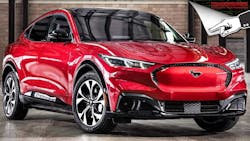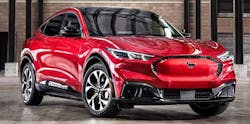Norwegian EV Startup Expected to Challenge Tesla’s Market Dominance
Download the entire collection of April 1st articles in PDF format.
From April 1st, 2021 @Evaluation Engineering
The Fjord Motor Company, a Norwegian electric-vehicle startup, has announced it’s accepting deposits for orders of its unique and revolutionary Mocky SUV Crossunder. The five-place Mocky is packed with all of the features offered by its competitors, including a 350HP fully electric drivetrain (available in 2- or 4-wheel drive), a 300-mile range, a center screen display, and reconfigurable seating.
However, that was only the beginning for Fjord's design team, who were determined to have the Mocky pull away from the pack with innovations that only the competitive brutality of a Viking-bred mind could dare to offer.
A New Twist on an Old Technology
The feature that stands out from other “green” automotive market leaders, like Tesla with its ultra-fast-charging vehicle offerings, and Toyota with its “self-charging” hybrids, is a true, off-grid, point-of-energy-source, self-charging capability. Fjord’s Mocky incorporates a patent-pending tire design, developed in collaboration with Korean global tire giant Yancancook, that features a water-wheel-like tread (see a quickly fashioned metal prototype in the video below) that’s said to have exceptional hydroplaning and snow/mud performance.
By incorporating electrohydraulic jacks behind the rear wheel wells, the Mocky can be charged by driving into any of the plentiful Norwegian rivers or streams, deploying the jacks while facing upstream and by commanding ChargeStream™ on the Mocky’s center-screen controls.
At that point, the following steps occur: the rear wheels get turned by the water flow; the vehicle naturally enters its regenerative braking mode; the high-voltage battery begins charging; and the cabin enters the now-industry-familiar “camping” mode. Fjord estimates 10% to 80% charging times of around 10 hours. It claims 110% charge efficiency due to excess battery heat not only being used for cabin warming, but the heat also makes dinner using a cleverly integrated fish-poaching pot located in the frunk (with its novel cargo-containment net having gill-net features incorporated so that it can be deployed to catch that meal).
For customers concerned about occasional family trips to the Sahara, the Fjord Mocky also has two J-1772 charge ports that enable an astounding 500-kW charge rate, with fish preparation times rivaling the best Long John Silver’s restaurant from all of the heat.
An Open-Source Autopilot
"Apart from killing Toyota’s ‘self-charging’ hubris, and Tesla’s now-Lilliputian charging rates and abilities, the only unaddressed advantage Tesla has over Fjord is autonomous self-driving, though Elon Musk has delivered more hot air than full capability to date," said Lief Niessan, CEO of The Fjord Motor Company.
“As a startup, we had limited engineering resources and cash available to us, so we looked for an AI (artificial intelligence) toolset that was available in the Open Source community to form the basis of the Mocky’s self-driving capability,” continued Niessan. “Our engineers worked closely with OpenAI and we managed to score a beta copy of their GPT-3 Artificial Intelligence toolset.”
For those unfamiliar with GPT-3, the toolset features an AI engine that was trained by crawling the entire expanse of the internet. GPT-3 has been demonstrated to compose music, write essays, perform medical diagnosis, and has even been used to complete partial photographs.
Niessan said, “Being trained on the contents of the internet can be interesting, though somewhat unpredictable, as we discovered during our self-driving system integration testing. The system, for instance, would add 2π MPH (or 3π kmh on metric highways) to the legal speed limit, having determined a speed that created the shortest travel times and carried an almost zero probability of a speeding citation being issued.”
Smarter than the Average AI
During highway testing in real-world conditions, Fjord discovered that the AI was watching the rearview mirror of a slower moving vehicle it was trailing in the leftmost lane of an interstate highway. When the system detected the driver’s rearward glance, the vehicle would speed up from its safe-follow distance to within 5 cm of vehicle contact, remain there while swerving quickly from side to side within its lane, and then back off to the safe-follow distance after the driver’s gaze was no longer present.
The common tactic of slow-driving “lane hogs” performing “brake checks,” by standing on the brakes while a vehicle wanting to pass is tailgating, proved futile to that driver due to the microsecond response times of the 600-MHz Arm processor the Fjord Mocky incorporates as the main computer. After the driver finally yielded the lane, the vehicle would resume its +2π MPH speeds.
However, one of Fjord’s interns noticed that the taillights of the Mocky didn’t have the usual striping we see from the LED multiplexing heterodyning with our telemetry-receiving van’s camera frame rate. She decided to review the Mocky’s code logs after that test session, and sure enough, the AI had written itself a code snippet in order to pulse the LEDs in Morse code, That signaled a very offensive expletive in Old Aramaic involving the driver’s mother and a goat. Thanks for the AI learnings, internet.
Another notable experience with the self-driving AI: During night driving, the side mirrors were observed being coarsely adjusted while the Mocky prototype was being closely followed by a vehicle with its high-beams on (see video below):
Trying to understand what intern-written-software bug caused the mirror adjustments, Fjord’s engineering team again found that the AI wrote itself a code snippet that was performing ray-tracing calculations to maximize the reflected intensity of the side mirrors back into that driver’s eyes. Needless to say, the interns are gaining a lot of weight by winning pizza bets that their code did not have bugs.
“We now find ourselves at an ethical quandary, though, on whether to deploy the AI in Fjord’s Mocky as is, in order to cull idiotic and selfish behaviors by other human drivers,” said Niessan, “or should we introduce some degree of incompetent-driver tolerance into our algorithms, by sensing, say, that the other driver is in a Subaru or a Volvo and then annealing the AI’s margins.”
Pricing for the base model Mocky 2WD starts at $39,995, which includes StreamCharge™, dual J-1772 DC charge ports, and the in-frunk fish-poaching pot. Also, $1 order deposits are being accepted on the company’s website at http://www.fjordmotorcompany.com/Mocky/orders as of April 1, 2021. While the cost of the self-driving option was not revealed by Fjord at press time, Lief assured us that active members of the Open Source community who deliver more than 500 lines of useful code to GitHub would receive the coveted autonomous EV option at no cost.
About the Author
Andy Turudic
Technology Editor, Electronic Design
Andy Turudic is a Technology Editor for Electronic Design Magazine, primarily covering Analog and Mixed-Signal circuits and devices. He holds a Bachelor's in EE from the University of Windsor (Ontario Canada) and has been involved in electronics, semiconductors, and gearhead stuff, for a bit over a half century.
"AndyT" brings his multidisciplinary engineering experience from companies that include National Semiconductor (now Texas Instruments), Altera (Intel), Agere, Zarlink, TriQuint,(now Qorvo), SW Bell (managing a research team at Bellcore, Bell Labs and Rockwell Science Center), Bell-Northern Research, and Northern Telecom and brings publisher employment experience as a paperboy for The Oshawa Times.
After hours, when he's not working on the latest invention to add to his portfolio of 16 issued US patents, he's lending advice and experience to the electric vehicle conversion community from his mountain lair in the Pacific Northwet[sic].
AndyT's engineering blog, "Nonlinearities," publishes the 1st and 3rd monday of each month. Andy's OpEd may appear at other times, with fair warning given by the Vu meter pic.


